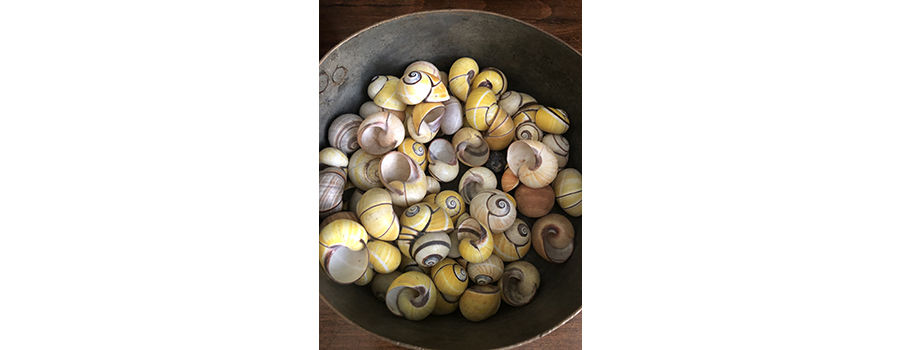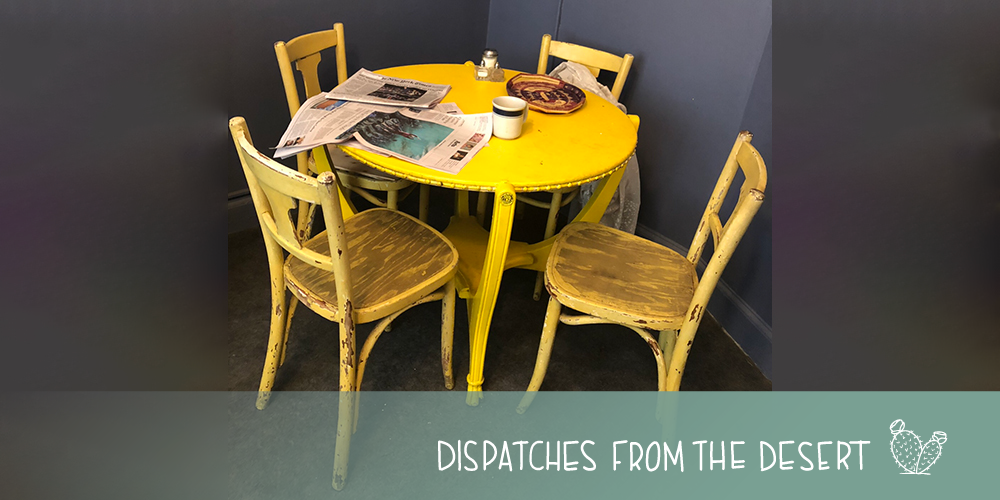10 April 2020
Castle Valley, Utah
can’t stop thinking about New York City and all its residents are going through as the coronavirus continues to sweep through its now empty streets and cubby holes, shops and apartment buildings. Governor Cuomo reported 824 deaths yesterday among the five boroughs. I think of the strength and stamina, courage and care of all the essential workers engaged in the city from doctors and nurses and paramedics, police and postal workers, grocery clerks, too many to name.
I recall the last time I was in New York sitting at this happy yellow table with my beloved friend Linda Asher eating breakfast together, toast with orange marmalade, hard boiled eggs and drinking cups of coffee — talking about the world and the books we were reading, news of our families and the marvel of textile and snippets of lace Linda had found at various tag sales. It all seemed fairly normal with only a hint of what was coming — and that was on March 2. I teased her for wearing a makeshift facemask, but she was right to be prudent.
After breakfast, we moved into the living room and sat on the green velvet couch with diffuse morning light streaming through the sheer curtains on to Linda’s busy desk of manuscripts and translations. This week she would have been honored by the American Academy of Arts and Letters with the Thornton Wilder Translation Prize. So deserved – but of course, it was cancelled. She comments on the cheerfulness of the extravagant cherry blossoms, unruly as they are, placed in the mauve ceramic pitcher in the corner of the room happily greeting visitors in the foyer. My eyes get distracted by the bowl of snail shells, she and her husband Aaron had collected in Cuba decades ago, also bright yellow. The apartment for over fifty years has been a living expression of a vibrant and intellectually rich life as evidenced by walls of bookshelves in every room, a piano in the study with musical scores and tapes of various composers punctuated by eclectic knick-knacks from all over the world.

Linda is healthy and safe in her apartment where her two daughters were raised and her grandchildren have dwelled and intimate soirees have been held. At 87, she is at risk with the coronavirus, but has been dutiful in staying home with the exception of venturing out a few Sunday’s back to bask in a glory of a day in Central Park. “There were so many New Yorker’s out walking, the scene was straight out of Seurat’s painting!” she exclaimed.
I came of age as a writer in this apartment under her love and mentorship. Through the years, after each visit to my editors, I would return home to Linda and report the happenings. Her good judgment guidance has made all the difference. If I haven’t told Linda about some episode in my life, it didn’t really happen. She both validates and challenges rigorously my assumptions. And then, we would walk the town, catching a movie, trying out a new café in the neighborhood or visit a vintage clothing shop on our way to a museum. I love New York City because of Linda’s vibrant energy and curiosity. She taught me to wear hats, strange hats for the pleasure and amusement of other people.
The day we met at a writer’s conference in Park City, Utah, was a blessed day in my life. We admired each other’s shoes. Always the adventurer, she wanted to see some of the famed Utah landscape. I gave her the keys to my car as Brooke handed her a map with detailed instructions of how to get to Zion National Park. She returned several days later with her own explanation of the profound nature of her experience. “The colors, the scale of the landscape, simply has to be explained through the malfunctioning of my eyes’ cones and rods.” This was July, 1986, six months before my mother died. They are the exact same age.
Linda Asher is part of the Jewish leftist intellectual New York. I am telling you this story because for me, she represents the best of this magnificent city – tough, smart, combative, hard working, full of style, and brilliance – and at times, her interrogations are exhausting. She spent two decades working as a respected fiction editor at The New Yorker. She is the only person I know with such a fresh and original use of language and love of words — so appreciative of their nimble and precise usage, that I secretly take notes so I won’t forget the surprise and ebullient nature of her sentences. “The daffodils were rising up just begging to be kissed.”
Linda’s husband Aaron Asher was a venerable editor serving in such capacities as editor in chief at Farrar, Straus, & Giroux and publisher of Grove Press. He worked with writers like Philip Roth, Arthur Miller and Milan Kundera. He died of cancer in 2008. He was both intimidating and tender. Out in the world, his impatience could be terrifying. I had the privilege of being edited by him on one occasion. He was a great reader and a good listener. He saw where I wanted to go and helped me get there by his searing questions. I wasn’t prepared for his gentleness. Both Linda and Aaron shared a love for the rigors and nuances of the editorial process. Their daughters Rachel and Abigail are dear friends as are their children. The Ashers are my New York family.
Our friendship has become our shared geographic relief. I visit them and they have visited us. Once, when Linda and I were in the Tetons, we encountered a black bear with three cubs on the switchbacks above Phelps Lake. Instinctively, Linda began singing an Italian aria. The bears stood up on the trail, stared, and listened for some time – before disappearing into the trees.
Memories like these in the days, weeks, and now months of the pandemic, bring joy and comfort and longing for the time when we can once again sit with friends around yellow kitchen tables and simply drink cups of coffee together and chat.
Linda and her family had a Zoom-style seder together, three generations present. She is in touch with friends. We talk often. Recently, on one of our telephone conversations I heard the 7:00 p.m. celebratory commotion in honor of the doctors and nurses serving the city. Linda held her phone out the window so I could hear the clamoring pans, horn honks and celebratory voices yelling out the window, “We love you! We thank you!” and I wept. For a brief moment, the isolation of New York was broken. We hung up shortly thereafter. I miss her and I worry. I think of all the apartment buildings in Manhattan, those living inside and those outside living on the streets alone.
7,067 individuals have died in New York state as of today, each of them carrying their own stories, now memories held in the hearts of those who loved them, now grieving. I think about the other 159,937 New Yorkers who have tested positive and the growing numbers rising in Utah.
T.S. Eliot reminds us “April is the cruelest month, breeding lilacs out of the dead land, mixing memory and desire, stirring. dull roots with spring rain.”
What a time this is...I wonder who we will become when we emerge?
Terry Tempest Williams
Mark your calendars for February 1, 2024! The Resiliency Center and the Center for Health Ethics, Arts, and Humanities are gearing up for the sixth Healthcare Stories event at Kingsbury Hall. This year's captivating theme, "Promise," invites healthcare professionals, patients, and community members to explore futures imagined, unexpected journeys, and transformative relationships.
University of Utah Black Cultural Center’s Meligha Garfield and Sara Cody share insights on celebrating Juneteenth respectfully and emphasize the importance of understanding its history to avoid misappropriation.
